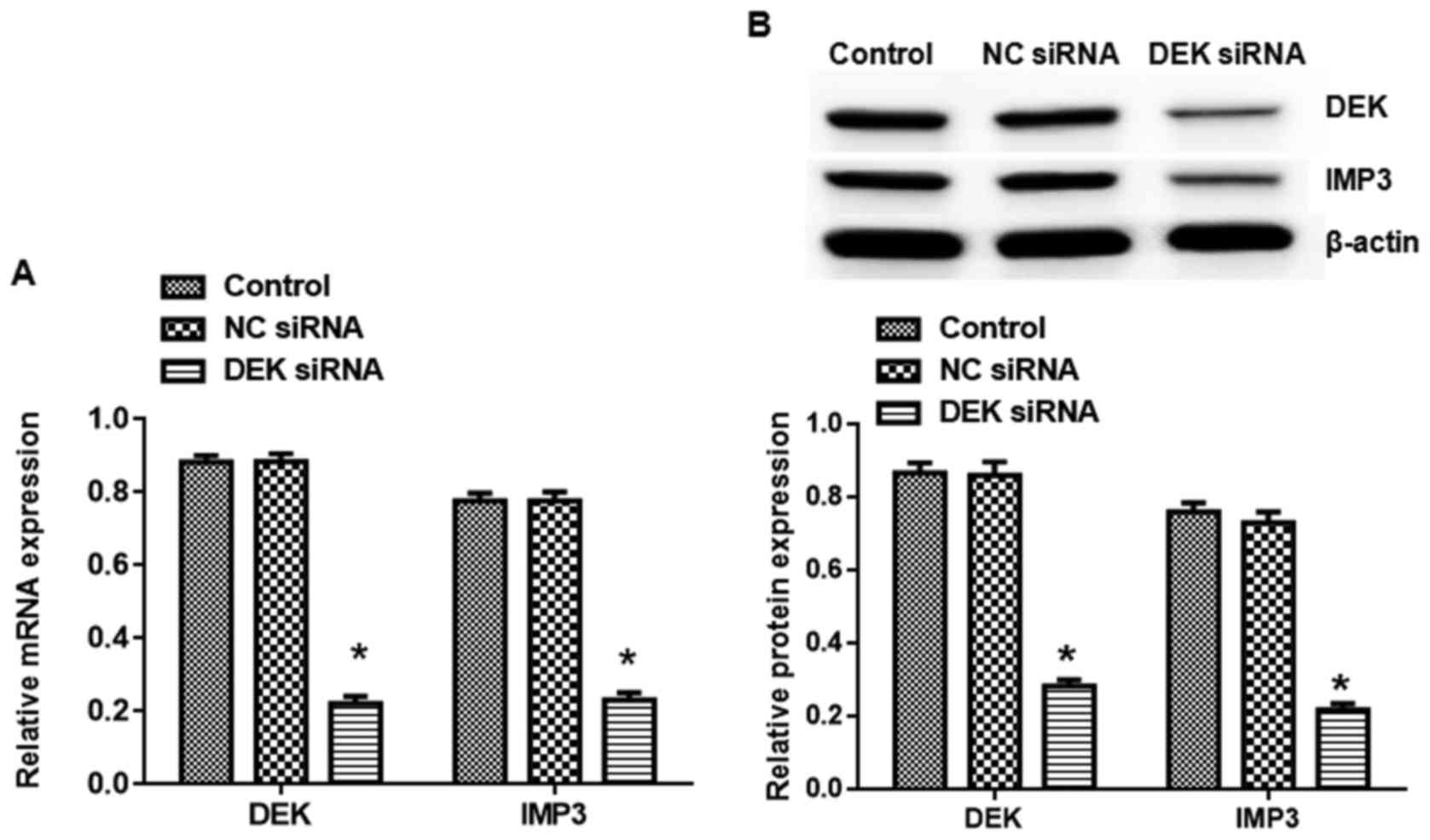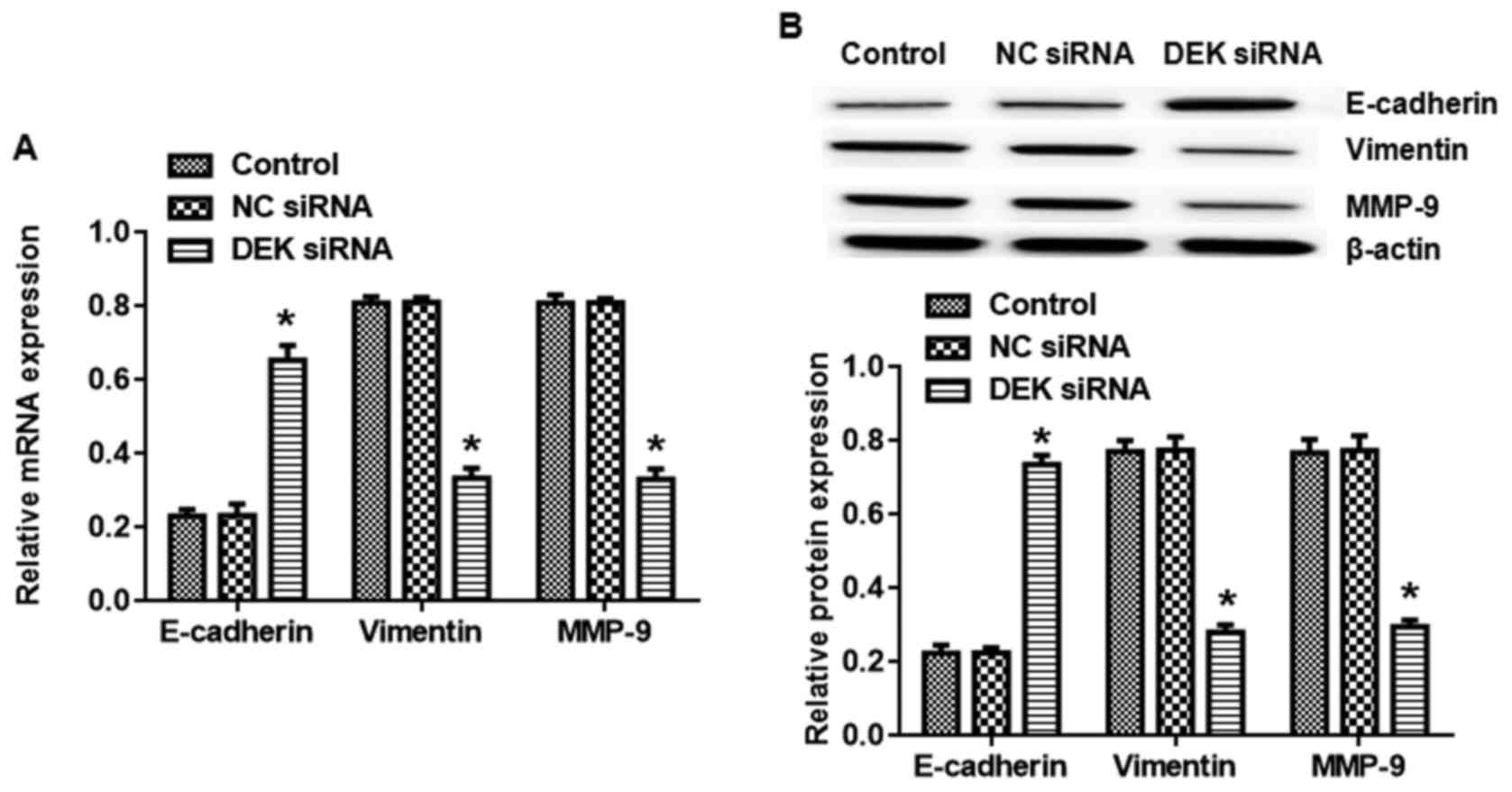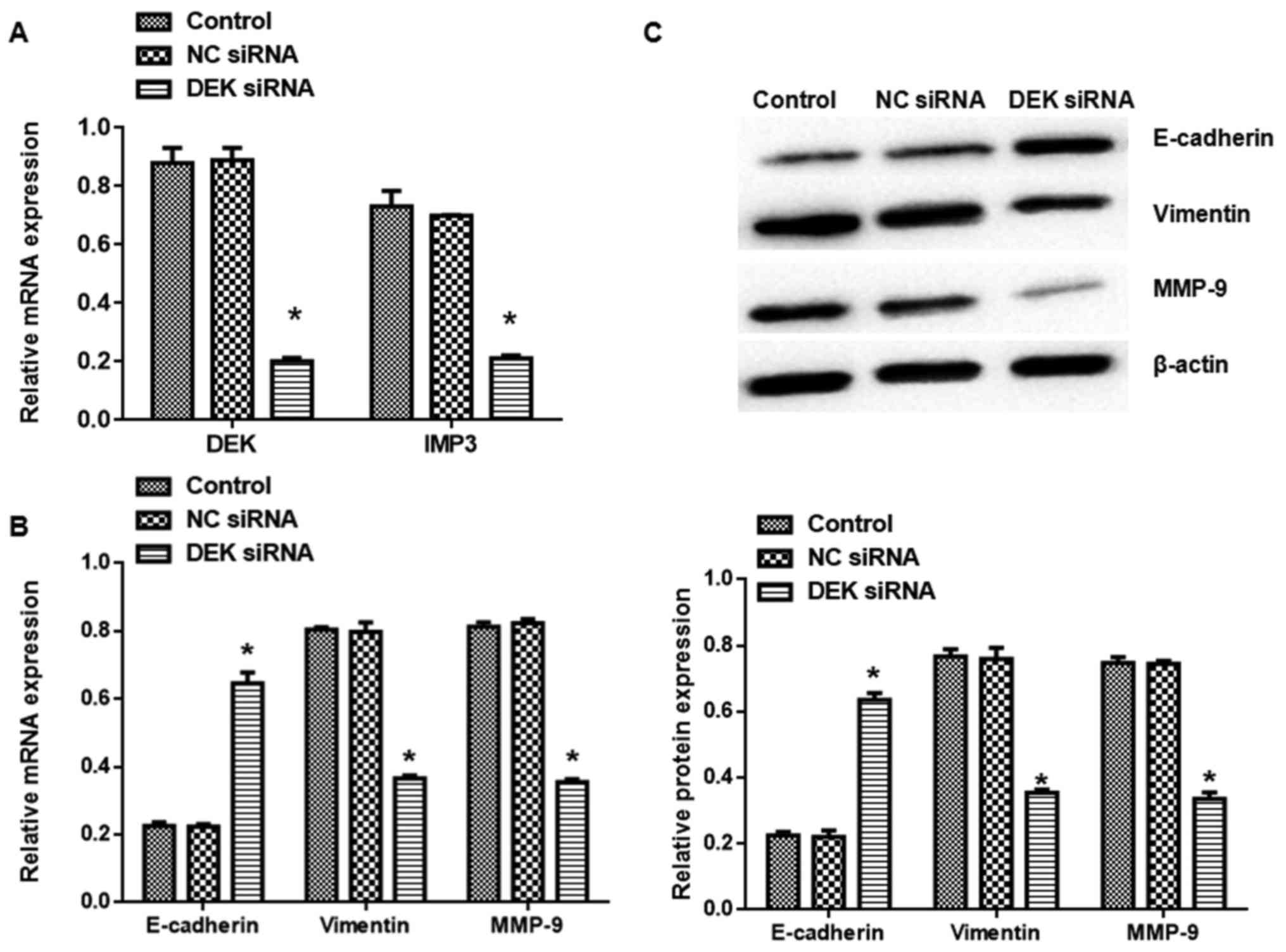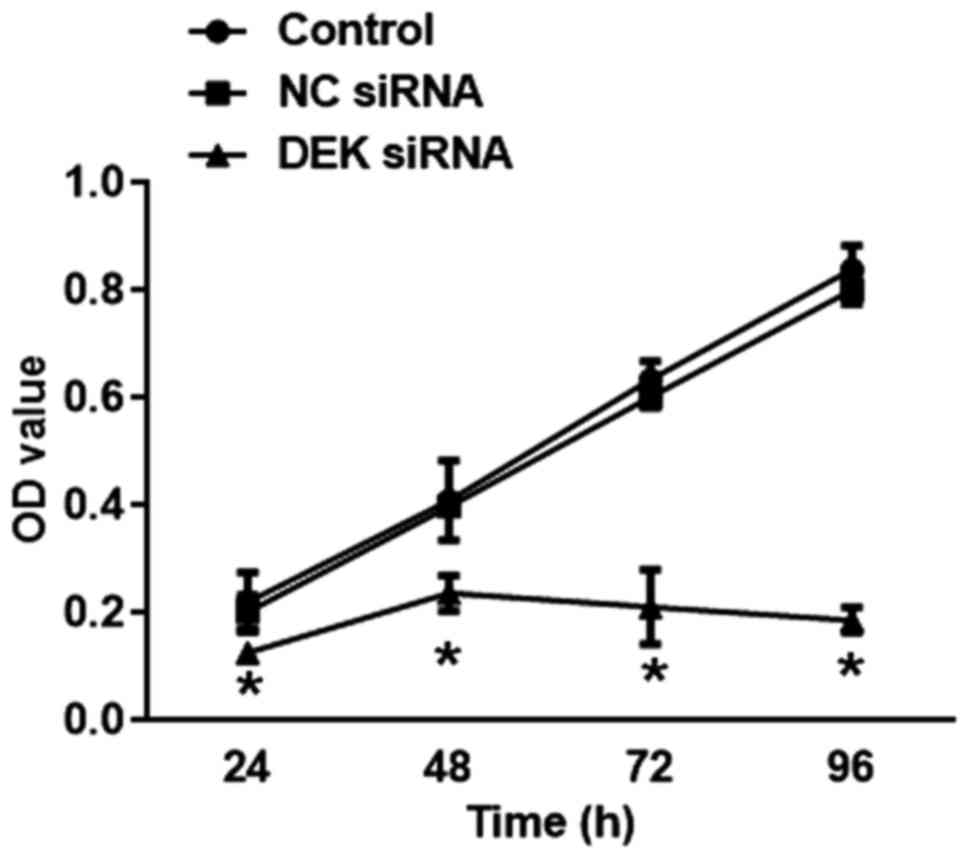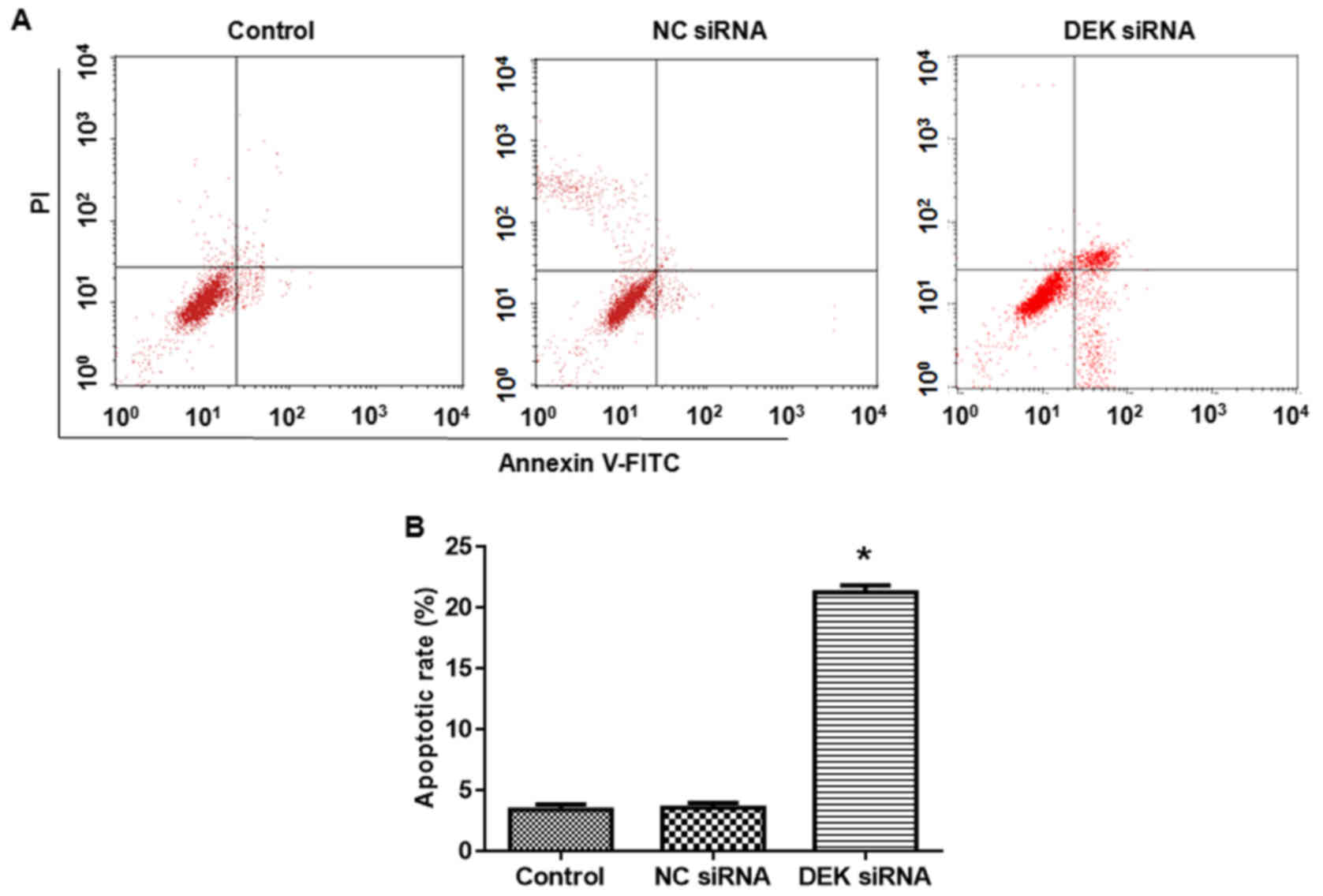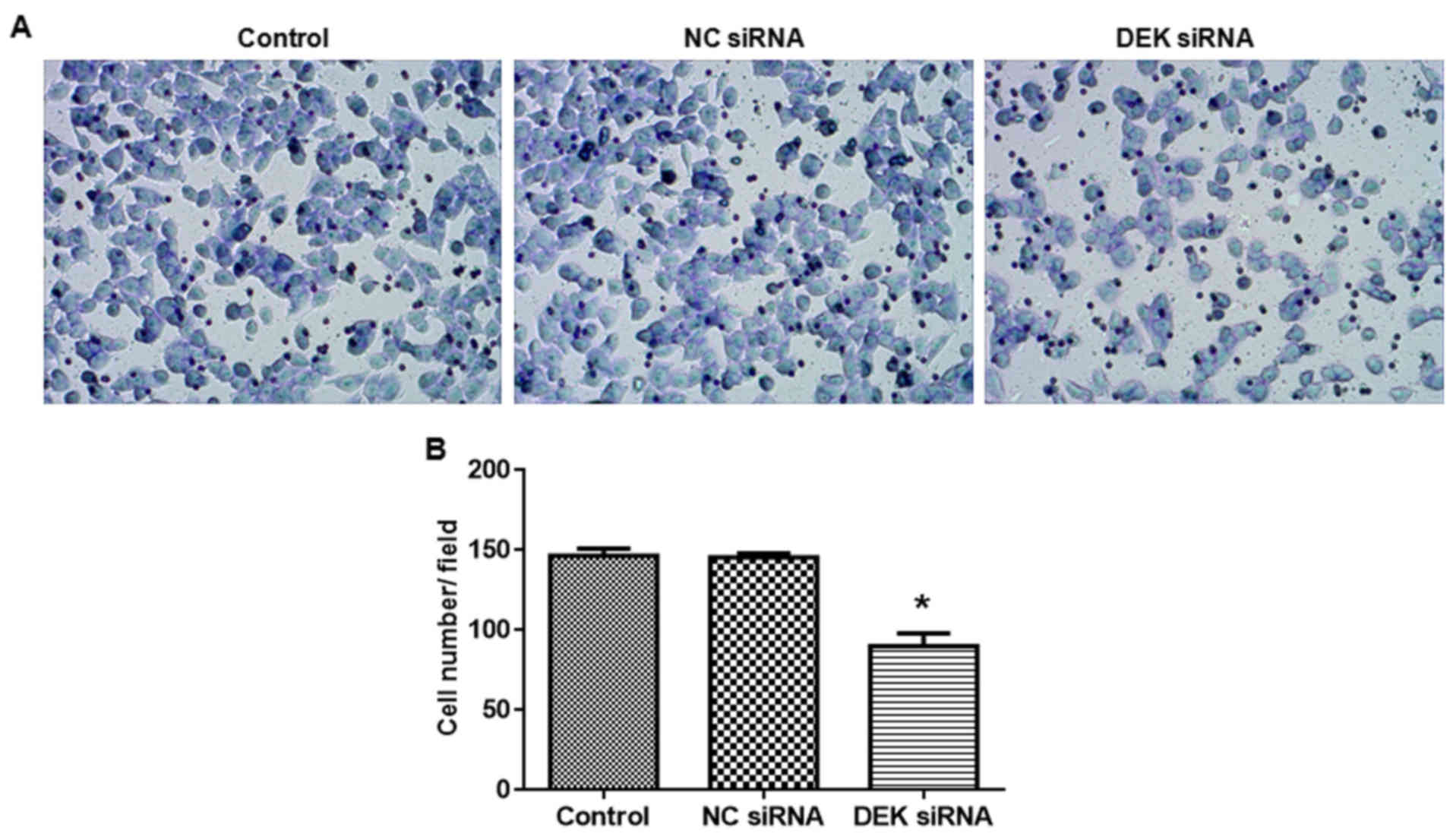Epithelial‑mesenchymal transition in colorectal carcinoma cells is mediated by DEK/IMP3
- Authors:
- Published online on: November 3, 2017 https://doi.org/10.3892/mmr.2017.7943
- Pages: 1065-1070
Abstract
Introduction
Colorectal carcinoma is one of the most common malignant tumors (1) with obviously increased metastasis and mortality in its advanced stage (2). Insulin-like growth factor II mRNA binding protein 3 (IMP3) is a kind of binding protein, which can specifically recognize mRNA sequence. It is also an oncofetal protein and expressed in a number of malignant tumors, related to the advances in tumor invasion. Invasion and metastasis of tumor cells might be modulated by the expression of IMP3 (3–5). Indeed, the members of IMPs family-IMP3 and IMP1 are applied as vital biological invasion markers for pancreatic cancer (6). Moreover, IMP3 expression in different stages of colorectal carcinoma was discrepant and IMP3 was expected to be a new target in the treatment of colorectal carcinoma (7).
As a pro-oncogene, DEK not only regulates cell senescence and apoptosis (8) but also the transcriptional regulator of retinoblastoma tumor suppressor protein (Rb)/E2F, which is often disturbed in colorectal carcinoma (9). DEK protein is highly-expressed in tumors and can be easily detected by commercial antibodies. Therefore, it holds great promise to be utilized as a tumor diagnostic marker. Benign and malignant melanoma could be easily identified according to the expression level of DEK (10). Moreover, DEK expression in undifferentiated cells was much higher than that in mature cells (11), which could be used to assess the differentiative capacity of tumor cells. In the present study, colorectal carcinoma cell lines SW620 and SW480 were selected. The cells were transfected with DEK interfering lentivirus and empty carrier, respectively. Consequently, effects of DEK silence on the cell viability, apoptosis, invasion and epithelial-mesenchymal transition (EMT) were detected.
Materials and methods
Cell culture and transfection
Colorectal carcinoma cell lines SW620 and SW480 (Shanghai Cell Bank of Chinese Academy of Science, China) were cultured in dulbecco minimum essential medium (DMEM) (Gibco, Grand Island, NY, USA) supplemented with 10% fetal bovine serum (FBS) (Hyclone; GE Healthcare Life Sciences, Logan, UT, USA) and 100 U/ml penicillin-streptomycin (Sigma, Ronkonkoma, NY, USA) in 5% CO2 at 37°C.
The experiment was divided into three groups: blank control, lentivirus encoding NC-siRNA, and lentivirus encoding DEK siRNA. The cells at 70% confluence were transfected with empty carrier and DEK interfering lentivirus (GenePharma, Shanghai, China), respectively. After 6 h, the medium were replaced with fresh DMEM medium (Gibco; Thermo Fisher Scientific, Inc., Waltham, MA, USA) containing 10% FBS. The cells were incubated in CO2 incubator at 37°C for 48 h. Finally, the expression levels of DEK and IMP3 in mRNA and protein levels were detected by quantitative real-time polymerase chain reaction (QRT-PCR) and western blot, respectively.
MTT assay
Colorectal carcinoma SW620 cells were seeded in 96-well plates. After transfection of 24, 48, 72 and 96 h, 20 µl medium with MTT (final concentration: 5 mg/ml) (Gibco; Thermo Fisher Scientific, Inc.) was added. After additional 4-h incubation in CO2 incubator at 37°C, the medium were discarded. DMSO (150 µl) (Sigma, USA) was added into each well and the plates were shaken to dissolve formazan sufficiently. The absorbance at 560 nm was recorded by a microplate reader (Thermo Fisher Scientific, Inc.). The optical density (OD) values represented cell viability.
Flow cytometry
Colorectal carcinoma SW620 cells were seeded in 6-well plates. After transfection of 48 h, the cells were collected after digestion by trypsin (Gibco; Thermo Fisher Scientific, Inc.). Under the protection from light, the cells were incubated with Annexin V-FITC/PI (C1062, Beyotime, Ningbo, China) for 30 min. Next, apoptosis was detected by flow cytometry (BD Company, Franklin Lakes, NJ, USA) within 1 h.
Transwell assay
After 48 h transfection, the cells were digested and seeded into the upper chamber of transwell. The lower chamber only contained DMEM medium. After 48 h incubation in CO2 incubator at 37°C, the down chamber was taken out and fixed with polyformaldehyde. After staining with crystal violet, inverted microscopy was used to count the cell numbers in five fields. The average number represented the capacity of cell invasion.
Quantitative real-time polymerase chain reaction (QRT-PCR)
After viral transfection, mRNA in different groups was extracted using a TRIzol assay kit (Baosheng Science & Technology Innovation Co, Ltd., Shanghai, China). mRNA was transcribed into cDNA according to the reverse transcription kit (639522, Takara Biotechnology Co., Ltd., Dalian, China) and fluorescence quantitative PCR was utilized to detect the expression level of the targeted genes using cDNA as template. The relevant expression level of E-cadherin, Vimentin and MMP-9 were normalized to β-actin. The primer sequences were listed as follows:
DEK-F: AAA CCT AGC CAG CTT CAC GA; DEK-R: AGG CCC AAC TGC AGA GAA AC; E-cadherin-F: CGC CGA GAG CTA CAC GTT CA; E-cadherin-R: TGT CGA CCG GTG CAA TCT TC; Vimentin-F: TGC GTG AAA TGG AAG AGA ACT; Vimentin-R: TGC GTG AAA TGG AAG AGA ACT; IMP3-F: GCG CTG CTG GAC AAG CTG TAT G; IMP3-R: AGG ACG AGG CCG TGA CGA A; MMP-9-F: CAT CTT CCA AGG CCA ATC C; MMP-9-R: CCA TCA CCG TCG AGT CAG C; β-actin-F: ACT CTT CCA GCC TTC CTT C, β-actin-R: ATC TCC TTC TGC ATC CTG TC.
Western blot analysis
Cell lysis solution was added into each group of cells. After 30 min dissociation at 4°C, the solutions were centrifuged at 11,670 g for 10 min. The supernatant was collected, which contained total protein. The protein concentration was measured by BCA kit (Beyotime). 20 µg protein in each group was loaded for gel electrophoresis and the membrane was transferred by wet methods. The antibodies, including anti-DEK (1:1,000, catalogue no. ab221545), anti-IMP3 (1:1,000, catalogue no. ab177477), anti-E-cadherin (1:1,000, catalogue no. ab1416), anti-Vimentin (1:1,000, catalogue no. ab8978; Abcam, Cambridge, UK), anti-MMP-9 (catalogue no. ab73734; 1:1,000; Abcam) and β-actin (1:1,000; catalogue no. AF0003, Beyotime Institute of Biotechnology, Shanghai, China) were incubated with nitrocellulose membranes overnight at 4°C. Next, the secondary antibody (1:100; catalogue nos. ab131368; Abcam) was added and co-incubated for 1–2 h at room temperature. ECL exposure liquid droplet (catalogue no. RPN2133; GE Healthcare Life Sciences, Chalfont, UK) was added on the membrane. In the end, the membrane was used for exposure utilizing gel imaging system (Bio-Rad Laboratories, Inc., Hercules, CA, USA). Grey density was analyzed using Quantity One analysis software v1.4.6 (Bio-Rad Laboratories, Inc.).
Statistical analysis
The data were presented as mean ± standard deviation (SD), and analyzed using SPPSS 17.0. Significant differences were calculated by t-test, where P<0.05 was considered to indicate a statistically significant difference.
Results
DEK silence down-regulates IMP3 expression and influences EMT
As shown in Fig. 1, the expression of DEK and IMP3 in mRNA and protein levels in DEK interfering lentivirus group was reduced significantly compared to the blank control group (P<0.05). By contrast, empty virus did not affect DEK and IMP3 expression in SW620 cells. Later, we assessed the effects of DEK silence on EMT. As shown in Fig. 2A, there was a significant enhancement in the mRNA level of E-cadherin and decrease in the mRNA level of Vimentin and MMP-9 when SW620 cells were treated with DEK interfering lentivirus (vs. blank control, P<0.05). Consistently, DEK silence also affected E-cadherin, Vimentin and MMP-9 protein expression in the similar trend (Fig. 2B). We also confirmed the effects of DEK silence on EMT in SW480 cells. DEK interfering lentivirus also decreased DEK and IMP3 mRNA expression (Fig. 3A). Interestingly, DEK silence also elevated E-cadherin and mitigated Vimentin and MMP-9 expression in both mRNA and protein levels (Fig. 3B and C).
DEK silence inhibits proliferation of colorectal carcinoma cells
As shown in Fig. 4, transfection of DEK interfering virus for 24, 48, 72, 96 h caused a drastic decrease in the percentage of the cell viability of SW620 cells in DEK interfering lentivirus group (vs. blank control, P<0.05).
DEK silence promotes apoptosis of colorectal carcinoma cells
Compared with the blank control group, the apoptotic rate of cells in DEK interfering lentivirus group was significantly elevated (vs. blank control, P<0.05, Fig. 5).
DEK silence inhibits cell invasion of colorectal carcinoma cells
As shown in Fig. 6, transfection of DEK interfering lentivirus significantly decreased the cell invasion ability (vs. blank control, P<0.05).
Discussion
IMP3 is a major component involved in epithelial-mesenchymal transition (7). Since IMP3 is a highly-conserved protein with the potential to bind to mRNA sequence. It is a main contributor in promoting embryonic development as a member of IMP family. Moreover, the expression level of IMP3 is obviously higher in embryonic period (6). In pathological conditions, the expression of IMP3 is elevated in various malignant tumors (7). In addition, there were researches demonstrating that the possibility of distant carcinoma metastasis was associated with unfavorable prognosis (12–15). DEK is a new member of DNA topology adjustment factors (10). The expression level of DEK is not only apparently related to cell proliferation and apoptosis but also affects the migration and invasion of colorectal carcinoma cells (16,17).
In this study, we applied colorectal carcinoma SW620 and SW480 cells as the cell models and constructed DEK interfering lentivirus. Once DEK was silenced, IMP3 expression was also reduced remarkably. These data indicated that DEK and IMP3 were associated in colorectal carcinoma. EMT is featured by the decrease of E-cadherin and increase of Vimentin (18). The up-regulation of E-cadherin expression can inhibit the invasion and metastasis of tumors, while down-regulation of E-cadherin is related to enhancement of invasion and metastasis (19,20). The invasion ability of tumor cells was inhibited after vimentin silence (21). Considering its high expression in various epithelial tumors, vimentin was thought to affect malignant degree of tumor cells (22). The aim of our study was to explore the regulatory effect of DEK/IMP3 pathway on EMT. The expression level of DEK protein was decreased by transfecting with DEK interfering lentivirus. Our data showed that cell invasion of colorectal carcinoma cells could be inhibited as a result of transfection of DEK interfering lentivirus. Cell morphology changed from interstitial-like spindle cells to epithelioid cells. Compared to the blank control group, the expression level of EMT-related markers E-cadherin was enhanced obviously, while the expression level of vimentin and MMP-9 were apparently down-regulated. It is possible that the expression of DEK was positively associated with vimentin and MMP-9 expression, while it was negatively correlated with E-cadherin expression. This result indicated that DEK played important roles in the regulation of epithelial mesenchymal transition in colorectal carcinoma. Consistently, interference of IMP3 could also significantly up-regulate the expression of E-cadherin in hepatocellular carcinoma (23).
Silence of DEK also decreased the invasion ability, reduced the cell viability and triggered apoptosis. Therefore, DEK played a vital role in regulating the invasion, viability and apoptosis of colorectal carcinoma cells. As demonstrated previously, DEK knockout could also cause apoptosis of cervical cancer cells. The possible mechanism was through p53 dependent apoptosis (24). In addition to the regulation of anti-apoptotic protein myeloid cell leukemia 1 (Mcl-1), DEK also regulates apoptosis (10). Liu et al demonstrated that silence of DEK contributed to apoptosis and senescence of cervical cancer cells (18).
In conclusion, our research demonstrated a regulatory mechanism of DEK on EMT of colorectal carcinoma cells which would finally influence the invasion of colorectal carcinoma cells. Our research provided theoretical guidance for the treatment of colorectal carcinoma.
References
|
Bordonaro M and Lazarova DL: CREB-binding protein, p300, butyrate, and Wnt signaling in colorectal cancer. Word J Gastroenterol. 21:8238–8248. 2015. View Article : Google Scholar | |
|
Wang J, Wang X, Lin S, Chen C, Wang C, Ma Q and Jiang B: Identification of kininogen-1 as a serum biomarker for the early detection of advanced colorectal adenoma and colorectal cancer. PLoS One. 8:e705192013. View Article : Google Scholar : PubMed/NCBI | |
|
Okada K, Fujiwara Y, Nakamura Y, Takiguchi S, Nakajima K, Miyata H, Yamasaki M, Kurokawa Y, Takahashi T, Mori M and Doki Y: Oncofetal protein, IMP3, a potential marker for prediction of postoperative peritoneal dissemination in gastric adenocarcinoma. J Surg Oncol. 105:780–785. 2012. View Article : Google Scholar : PubMed/NCBI | |
|
Li D, Yan D, Tang H, Zhou C, Fan J, Li S, Wang X, Xia J, Huang F, Qiu G and Peng Z: IMP3 is a novel prognostic marker that correlates with colon cancer progression and pathogenesis. Ann Surg Oncol. 16:3499–3506. 2009. View Article : Google Scholar : PubMed/NCBI | |
|
Perak Beljan R, Durdov MG, Capkun V, Ivcevic V, Pavlovic A, Soljic V and Peric M: IMP3 can predict aggressive behaviour of lung adenocarcinoma. Diagn Pathol. 7:1652012. View Article : Google Scholar : PubMed/NCBI | |
|
Yantiss RK, Woda BA, Fanger GR, Kalos M, Whalen GF, Tada H, Andersen DK, Rock KL and Dresser K: KOC (K honlology domain containing protein overexpressed in cancer): A novel molecular maker that distinguishes between benign and malignant lesions of the pancreas. Am J Surg Pathol. 29:188–195. 2005. View Article : Google Scholar : PubMed/NCBI | |
|
Kumara Shantha H, Kirchoff D, Caballero OL, Su T, Ahmed A, Herath SA, Njoh L, Cekic V, Simpson AJ, Cordon-Cardo C and Whelan RL: Expression of the cancer testis antigen IGF2BP3 in colorectal cancers; IGF2BP3 holds promise as a specific immunotherapy target. Oncoscience. 2:607–614. 2015. View Article : Google Scholar : PubMed/NCBI | |
|
Riveiro-Falkenbach E and Soengas MS: Control of tumorigenesis and chenoresistance by the DEK oncogene. Clin Cancer Res. 16:2932–2938. 2010. View Article : Google Scholar : PubMed/NCBI | |
|
Huang L, Xu Y, Cai G, Guan Z and Cai S: Downregulation of S100A4 expression by RNA interference suppresses cell growth and invasion in human colorectal cancer cells. Oncol Rep. 27:917–922. 2012. View Article : Google Scholar : PubMed/NCBI | |
|
Khodadoust MS, Verhaegen M, Kappes F, Riveiro-Falkenbach E, Cigudosa JC, Kim DS, Chinnaiyan AM, Markovitz DM and Soengas MS: Melanoma proliferation and chemoresistance controlled by the DEK oncogene. Cancer Res. 69:6405–6413. 2009. View Article : Google Scholar : PubMed/NCBI | |
|
Oyarzo MP, Lin P, Glassman A, Bueso-Ramos CE, Luthra R and Medeiros LJ: Acute myeloid leukemia with t(6;9)(p23;q34) is associated with dysplasia and a high frequency of flt3 gene mutations. Am J Clin Pathol. 122:348–358. 2004. View Article : Google Scholar : PubMed/NCBI | |
|
Lederer M, Bley N, Schleifer C and Hüttelmaier S: The role of the oncofetal IGF2 mRNA-binding protein 3 (IGF2BP3) in cancer. Semin Cancer Biol. 29:3–12. 2014. View Article : Google Scholar : PubMed/NCBI | |
|
Bell JL, Wächter K, Mühleck B, Pazaitis N, Köhn M, Lederer M and Hüttelmaier S: Insulin-like growth factor 2 mRNA-binding proteins (IGF2BPs): Post-transcriptional drivers of cancer progression? Cell Mol Life Sci. 70:2657–2675. 2013. View Article : Google Scholar : PubMed/NCBI | |
|
Park JY, Choe M, Kang Y and Lee SS: IMP3, a promising prognostic marker in clear cell renal cell carcinoma. Korean J Pathol. 48:108–116. 2014. View Article : Google Scholar : PubMed/NCBI | |
|
Wang L, Li HG, Xia ZS, Lü J and Peng TS: IMP3 is a novel biomarker to predict metastasis and prognosis of gastric adenocarcinoma: A retrospective study. Chin Med J (Engl). 123:3554–3558. 2010.PubMed/NCBI | |
|
Lin L, Piao J, Ma Y, Jin T, Quan C, Kong J, Li Y and Lin Z: Mechanisms underlying cancer growth and apoptosis by DEK overexpression in colorcetal cancer. PLoS One. 9:e1112602014. View Article : Google Scholar : PubMed/NCBI | |
|
Lin L, Piao J, Gao W, Piao Y, Jin G, Ma Y, Li J and Lin Z: DEK over expression as an independent biomarker for poor prognosis in colorectal cancer. BMC Cancer. 13:3662013. View Article : Google Scholar : PubMed/NCBI | |
|
Liu K, Feng T, Liu J, Zhong M and Zhang S: Silencing of the DEK gene induces apoptosis and senescence in CaSki cervical carcinoma cells via the up-regulation of NF-κB p65. Biosci Rep. 32:323–332. 2012. View Article : Google Scholar : PubMed/NCBI | |
|
Cavallaro U and Christofori G: Cell adhesion and signalling by cadherins and Ig-CAMs in cancer. Nat Rev Cancer. 4:118–132. 2004. View Article : Google Scholar : PubMed/NCBI | |
|
Oliveras-Ferraros C, Corominas-Faja B, Cufí S, Vazquez-Martin A, Martin-Castillo B, Iglesias JM, López-Bonet E, Martin ÁG and Menendez JA: Epithelial-to-mesenchymal transition (EMT) confers primary resistance to trastuzumab (Herceptin). Cell Cycle. 11:4020–4032. 2012. View Article : Google Scholar : PubMed/NCBI | |
|
Sarkar FH, Li Y, Wang Z and Kong D: Pancreatic cancer stem cells and EMT in drug resistance and metastasis. Minerva Chir. 64:489–500. 2009.PubMed/NCBI | |
|
Jeng YM, Chang CC, Hu FC, Chou HY, Kao HL, Wang TH and Hsu HC: RNA-binding protein insulin-like growth factor II mRNA-binding protein 3 expression promotes tumor invasion and predicts early recurrence and poor prognosis in hepatocellular carcinoma. Hepatology. 48:1118–1127. 2008. View Article : Google Scholar : PubMed/NCBI | |
|
Chen C, Wang FH, An X, Luo HY, Wang ZQ, Liang Y, Zhang L and Li YH: Triplet combination with paclitaxel, cisplatin and 5-FU is effective in metastatic and/or recurrent nasopharyngeal carcinoma. Cancer Chemother Pharmacol. 71:371–378. 2013. View Article : Google Scholar : PubMed/NCBI | |
|
Wise-Draper TM, Allen HV, Jones EE, Habash KB, Matsuo H and Wells SI: Apoptosis inhibition by the human DEK oncoprotein involves interfer-ence with p53 functions. Mol Cell Biol. 26:7506–7519. 2006. View Article : Google Scholar : PubMed/NCBI |



